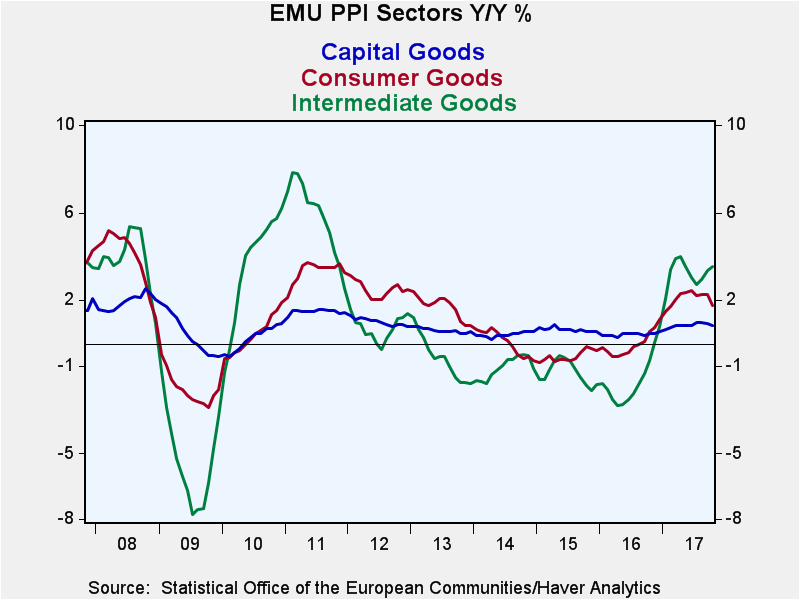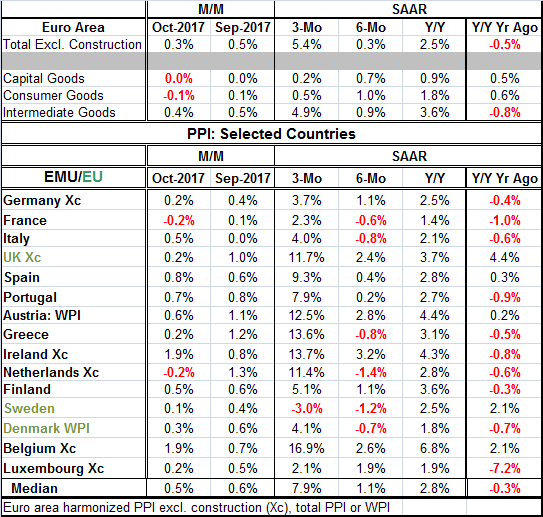 Global| Dec 04 2017
Global| Dec 04 2017Euro Area PPI Slows in October But Is Still Accelerating Over three Months
Summary
The euro area PPI slowed to a gain of 0.3% in October after a 0.5% advance in September. But its three-month rise, at 5.4%, is still faster than its six-month pace (0.3%) and shows acceleration compared to its year-on-year pace of [...]
 The euro area PPI slowed to a gain of 0.3% in October after a 0.5% advance in September. But its three-month rise, at 5.4%, is still faster than its six-month pace (0.3%) and shows acceleration compared to its year-on-year pace of 2.5%. However, the entire effect is the result of pressure on intermediate goods prices.
The euro area PPI slowed to a gain of 0.3% in October after a 0.5% advance in September. But its three-month rise, at 5.4%, is still faster than its six-month pace (0.3%) and shows acceleration compared to its year-on-year pace of 2.5%. However, the entire effect is the result of pressure on intermediate goods prices.
Capital goods prices are steadily decelerating from 12-month to six-month to three-month. Consumer goods prices are also decelerating on that timeline. But intermediate goods prices are in an erratic acceleration with their three-month gain at a 4.9% pace, higher than six-month and 12-month. However, there is no steady acceleration because the six-month rate sags to pace below 1%, below the 12-month gain of 3.6%. Except for intermediate goods, producer prices in the EMU are actually showing decelerating tendencies.
By country, there is still a good deal of difference. In October, only two countries, France and the Netherlands, show a decline in their respective PPIs. In addition, there are decelerations in another eight countries (that total includes three that are not EMU members). Over three months all countries in the table except Sweden show acceleration. However, that is partly because over six months every country in the table saw the pace off PPI inflation fall below its year-on-year pace except for Luxembourg where it was unchanged. And finally year-on-year inflation in the EMU was substantially higher in October than it was in October of one year ago when prices were largely still falling.
Inflation continues to rank high consistently in Ireland, Belgium and Austria. Inflation is consistently low in Sweden and Italy- surprisingly enough as well as in France. Inflation by ranking among member countries has been falling the most consistently in Italy, Sweden and Finland. It has been rising the most consistently in Ireland and Austria.
On balance, EMU inflation is still being pushed around by fluctuating energy prices. And the outlook for energy prices is still uncertain even in the wake of OPEC and friends extending their output restricting agreement. Drilling activity in the U.S. continues to expand. On the whole, PPI inflation remains in a fluctuating mode, but inflation overall still appears to remain contained.

Robert Brusca
AuthorMore in Author Profile »Robert A. Brusca is Chief Economist of Fact and Opinion Economics, a consulting firm he founded in Manhattan. He has been an economist on Wall Street for over 25 years. He has visited central banking and large institutional clients in over 30 countries in his career as an economist. Mr. Brusca was a Divisional Research Chief at the Federal Reserve Bank of NY (Chief of the International Financial markets Division), a Fed Watcher at Irving Trust and Chief Economist at Nikko Securities International. He is widely quoted and appears in various media. Mr. Brusca holds an MA and Ph.D. in economics from Michigan State University and a BA in Economics from the University of Michigan. His research pursues his strong interests in non aligned policy economics as well as international economics. FAO Economics’ research targets investors to assist them in making better investment decisions in stocks, bonds and in a variety of international assets. The company does not manage money and has no conflicts in giving economic advice.






